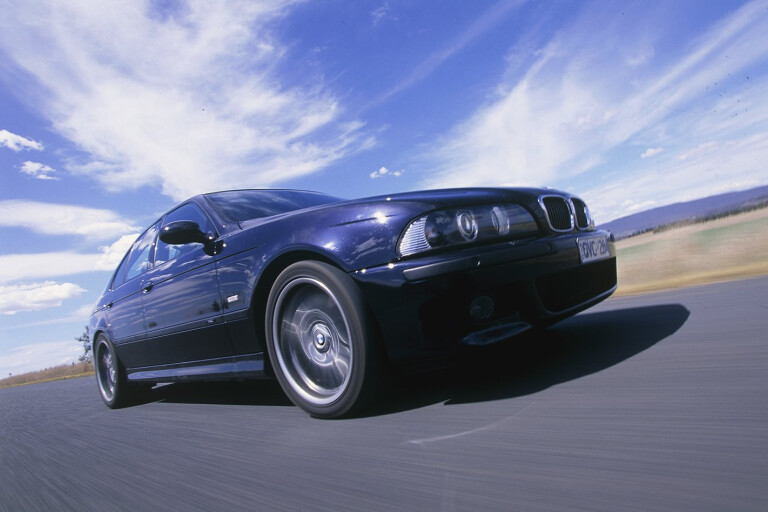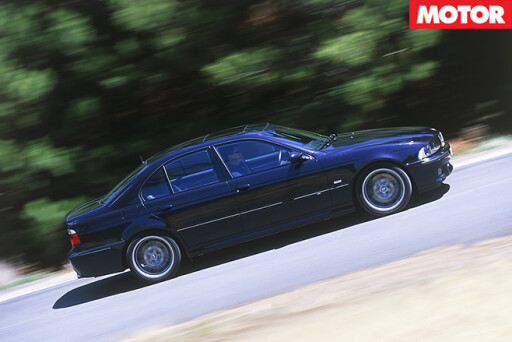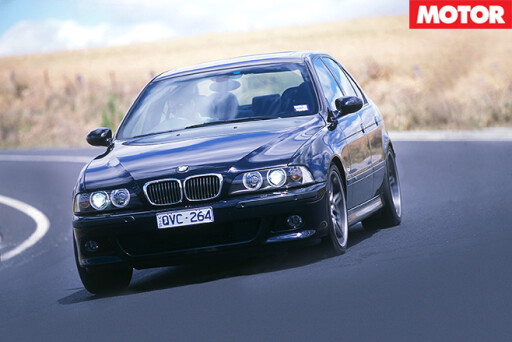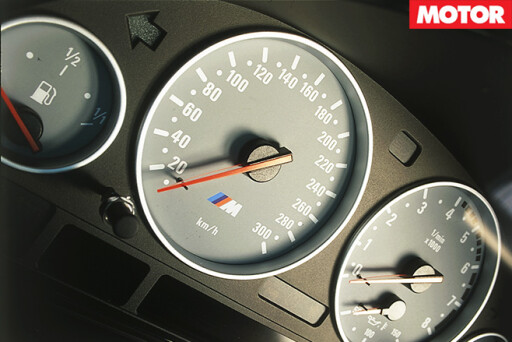
If you really want my opinion (or if it’s my money we’re spending) then there’s really only one BMW M5 I want parked in my shed.
This story was originally published in the October 2005 issue of MOTOR.
Oh sure, the current-model twin-turbo bruiser is a slingshot par excellence and, for many folks the be-all-and-end-all. But for mefatself, it’s just got to be an E34, complete with that rippling straight-six.
But where does that leave the E39 version of the M5; you know, the one with the atmo V8? Actually, neither the birth of the boosted eight, the screaming F1-esque V10 nor the quirky proclivities of we inline-six pervs can take anything away from the E39, because any way you cut the deck, it’s one of the most rapid, capable four-doors on the planet, regardless of badge or price.
 If there’s a single element of the M5 throughout the ages that stands out as a defining characteristic, it’s been the fact the whole package has always been dominated by its powerplant.
If there’s a single element of the M5 throughout the ages that stands out as a defining characteristic, it’s been the fact the whole package has always been dominated by its powerplant.
This seems a little strange given there’s no signature layout or cylinder tally, but it makes sense when you consider that no M5 has ever really wanted for more engine. Six, eight or 10-potter it doesn’t matter; not when the end result is inevitably such a ball-tearer.
For the E39, BMW’s M-tuners took the standard 4.4-litre V8 as seen in more pedestrian versions of the 5-Series, turned it inside out, and wound up with one of the true über-mills of the late ’90s. Actually, it’s not just a bored-out version of the S62 V8, it was a specific casting which hogged out the holes to allow for a 94mm bore instead of the S62’s 92mm.
Downstairs, BMW went along its favourite track and stroked the bugger. We’re not talking a little stretch either; think 89mm versus the 4.4’s 82.7mm, so the capacity hike from 4.4 to nearly a full 5.0 litres (actually, it's a 4.9, but don't let the truth get in the way of marketing) is more about stroke than simply bigger slugs. As such, BMW had to develop a specific three-layer steel head gasket.
 Heck, Ethel, even the lubrication system has been carefully thought out to account for the fact that the M5 can allegedly produce a full one-g on the skidpan.
Heck, Ethel, even the lubrication system has been carefully thought out to account for the fact that the M5 can allegedly produce a full one-g on the skidpan.
As well as the usual oil pump, there’s also a single scavenging pump for each bank of cylinders. In normal driving, these pick up oil from the back of the engine and return it to the sump.
But when things start getting jiggy, the on-board lateral g-force sensor detects big side forces and switches the scavenging pumps to a different pick-up point at the outer side of each cylinder head. Smart? You wouldn’t want to challenge an M5 to a game of Trivial Pursuit.
Throw in the trick manifolding and double VANOS (variable valve timing) and you’re staring at some big numbers. Try 294kW and a neat 500Nm, making the V8 yet one more normally aspirated BMW engine that cracks the magic 100Nm per litre mark.
 Unlike a few other ‘modern’ 5.0-litre-and-above V8s we could name, the Bimmer’s wedge made shedloads of fat, meaty torque way down low in the rev range. Forget about needing 4000rpm showing before anything happened, because the M5 was well and truly stoked up by the time the tacho needle was pointing at about the ‘2’ notch.
Unlike a few other ‘modern’ 5.0-litre-and-above V8s we could name, the Bimmer’s wedge made shedloads of fat, meaty torque way down low in the rev range. Forget about needing 4000rpm showing before anything happened, because the M5 was well and truly stoked up by the time the tacho needle was pointing at about the ‘2’ notch.
For all that, it wails too when you get fair up it, and the redline is easily tagged (as is the limiter) if you’re up to the challenge. Meanwhile, there’s a beaut soundtrack to go with it and even if those four, big stainless zorst pipes seem a bit over the top, you’ve got to admit it sounds like a proper big-inch V8 from both within and without.
It’s perhaps a little odd that BMW never offered an automatic gearbox option on the E39 M5, especially since it was aimed at rich buggers. Still, we’d have taken the six-speed manual every time purely because the fastest Five was such a performance car in every other regard.
One mechanic I talked to about the M5 was of the opinion that BMW was almost having a lend calling the car an E39 in the first place. The logic there is that there’s virtually no component interchangeability between the M and lesser Fives. Meanwhile, the suspension, driveline and brakes are all M5-specific and that’s part of the reason the thing was such a stormer: It doesn’t feel like a warmed up Munich taxi, because it isn’t one.
 If the only V8s you’ve ever driven are the Gen III and Ford’s DOHC mill, then you are seriously unprepared for your first drive in an E39 M5. If, on the other hand, you’re familiar with injected 429 Cobra Jets, you’re getting warmer.
If the only V8s you’ve ever driven are the Gen III and Ford’s DOHC mill, then you are seriously unprepared for your first drive in an E39 M5. If, on the other hand, you’re familiar with injected 429 Cobra Jets, you’re getting warmer.
The M5 not only accelerates like a bastard, it does so effortlessly and with absolutely zero fuss. There’s no thrashing from the valve gear, no strained, whining noises from the driveline and no clumsy clutch-gearstick action. It just buggers off, that’s all.
Top speed is limited to about 250km/h, but you should reach 100km/h in a low-five and cover the standing quarter in under 13.5 seconds. Inherent ability and BMW’s legendary damping prowess make sure the M5 is just about unstoppable as a road car.
Sure, the ride is firmish by limousine standards, but it’s an absolute armchair compared with a lot of other performance sedans. Part of that must surely be the kerb mass which tops out at the best part of 1800kg with a full tank of PULP on board.
 The flip-side is that the big Bimmer ain’t so happy on a racetrack. We’ve done enough laps on enough circuits in M5s to know that she’s a bit of a lead-tipped arrow. Up to about eight-tenths, it’s fine, but push it all the way and it starts to understeer on the corner entry and right through the apex. It’s not a problem on the road (unless you’re a complete tool with no regard for anybody’s well-being) but it does pretty much rule the M5 out of track-day duties. There, there.
The flip-side is that the big Bimmer ain’t so happy on a racetrack. We’ve done enough laps on enough circuits in M5s to know that she’s a bit of a lead-tipped arrow. Up to about eight-tenths, it’s fine, but push it all the way and it starts to understeer on the corner entry and right through the apex. It’s not a problem on the road (unless you’re a complete tool with no regard for anybody’s well-being) but it does pretty much rule the M5 out of track-day duties. There, there.
The rest of the package is just what you’d expect from a late-model BMW costing a bee’s dick short of $200,000 when it was brand spanking. The standard equipment list is long and heavily weighted towards electrical gizmos that relieve you of the obligation to actually do anything apart from steer and change gears.
Even the tacho is smarter than the average bear with a variable redline that changes according to whether the engine oil is fully warmed through or not.
 And it doesn’t really matter what you think of the new 5-Series bodyshell, because we’re yet to meet anybody who doesn’t think the E39 was a tough, aggressive looking piece of work. Throw in the black-chrome wheels and bodykit and not even your dopiest neighbours could misinterpret just what an M5 is all about.
And it doesn’t really matter what you think of the new 5-Series bodyshell, because we’re yet to meet anybody who doesn’t think the E39 was a tough, aggressive looking piece of work. Throw in the black-chrome wheels and bodykit and not even your dopiest neighbours could misinterpret just what an M5 is all about.
And that’s really a big part of the deal, isn’t it? There’s absolutely no doubt that an E39 still looks the business and hasn’t yet started to show its age in any area. The fact you’re buying a near-new car for around a quarter of its original price is a fact of luxury-car life and while it must keep accountants awake at night, it’s brilliant news for the likes of us.
The problem with the relative scarcity of the M5 is that no mechanics we talked to had seen a whole bunch of them through the door, so finding out what really goes wrong with them is a bit more hit and miss than it would be for a Camry. That said, it appears the drivelines are more or less bulletproof and only the odd electrical gremlin seems to upset ye olde applecarte.
 But, the thing is a performance car, after all, so expect any example you look at to be well used in some regards. Make sure you check the front rotors for distortion and thickness because, like we said, they’re not interchangeable for anything else in the 5-Series line-up.
But, the thing is a performance car, after all, so expect any example you look at to be well used in some regards. Make sure you check the front rotors for distortion and thickness because, like we said, they’re not interchangeable for anything else in the 5-Series line-up.
Oh, and a new one will set you back better than a grand. Er, and there’s two of them, remember.
Other than that, look out for crash damage and anything that leads you to believe it's been club raced (rare, but possible), if you can see evidence of it, then steer a wide berth. See, correctly repaired damage shouldn’t be visible at all and a car like an M5 will only ever be as good as the maintenance and repairs that have been foisted upon it.
SPECS
Body: 4-door sedan
Drive: rear-wheel
Engine: 4941cc V8, DOHC, 32v
Power: 294kW @ 6600rpm
Torque: 500Nm @ 3800rpm
Compression ratio: 11.0:1
Bore x Stroke: 94.0mm x 89.0mm
Weight: 1790kg
Weight/Power: 6.08kg/kW
Specific Power: 60.0kW/litre
Transmission: six-speed manual
Suspension: MacPherson struts, coil springs, anti-roll bar (f); multi-link, coil springs, anti-roll bar (r)
L/W/H: 4784/1800/1437mm
Wheelbase: 2830mm
Track: 1515mm (f); 1527mm (r)
Brakes: 345mm ventilated discs, two-piston calipers (f); 328mm ventilated discs, two-piston calipers (r), ABS
Wheels: 18 x 8.0 inch (f); 18 x 9.5-inch (r), alloy
Tyres: Dunlop SP Sport 8000, 245/40 ZR18 (f); 275/35 ZR18 (r)
Fuel: 70 litres, PULP
Price: $198,500 (December 2002)
FAST TIMES
0-100km/h 5.19secs
0-400m 13.46 @ 172km/h

COMMENTS